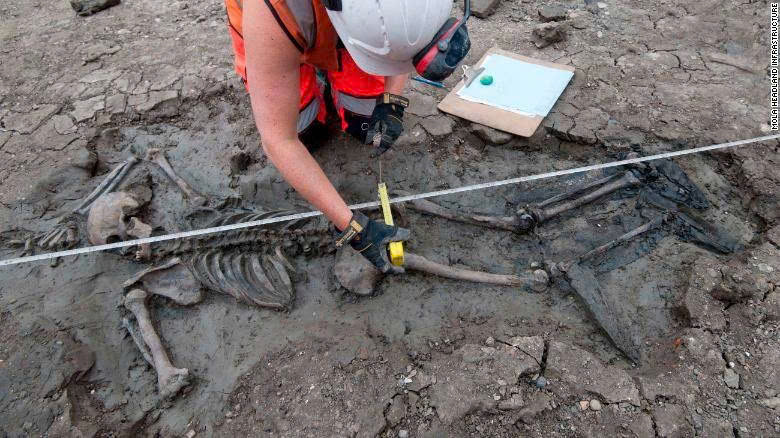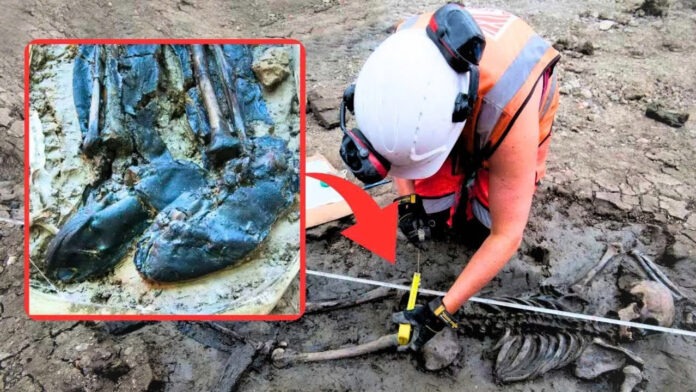Discovery Along London’s Historic Riverbank
Beneath the bustling streets of modern London, the city’s history continues to reveal itself in unexpected ways. Construction workers expanding London’s vast new sewage network unearthed an extraordinary find along the Thames in Bermondsey, south London: the remarkably preserved remains of a man who lived—and died—approximately five centuries ago. What makes the discovery exceptional is that the skeleton was still wearing his leather boots, thigh-high and almost perfectly intact despite lying buried in river mud for hundreds of years.
Archaeologists from MOLA Headland, the firm overseeing the project, immediately recognized the significance. The man’s remains, discovered face-down in the thick, oxygen-deprived mud of the riverbank, had been naturally preserved by the Thames’s unique tidal environment. In these conditions, leather can survive for centuries — even as most organic materials decay. The result is one of the most striking archaeological finds in recent London history.
The £5.4 Billion Super Sewer Project Reveals Hidden History

The skeleton was discovered during work on London’s £5.4 billion “super sewer” project — a massive infrastructure effort to modernize the city’s Victorian-era drainage system. The project, designed to prevent sewage overflow into the Thames, has uncovered layer upon layer of London’s forgotten past as engineers dig deep below the modern metropolis.
Work at the Bermondsey site was immediately halted to allow for full archaeological examination. The excavation revealed that the man had died near the riverbank, likely in the late 15th or early 16th century, during the Tudor period. Artifacts and sediment layers around the site confirmed the historical dating, linking the remains to an era when London’s riverfront was a bustling center of trade, shipbuilding, and industry.
Unusual Burial Circumstances Point to Accidental Death
Archaeologists quickly ruled out the possibility of a deliberate burial. During Tudor England, leather was a valuable commodity — often repaired and reused until it disintegrated. It was unlikely that anyone would intentionally bury a person wearing such expensive boots. Instead, experts believe the man’s death was sudden and accidental.
Historical accounts describe the Thames as both a lifeline and a hazard. Its shifting tides and slippery banks claimed many lives, especially among those who worked close to the water. Archaeologists suggest that the victim may have been a fisherman, a dock laborer, a sailor, or a “mudlark” — a scavenger who searched the tidal flats for coins, scrap, or lost cargo.
The position of the skeleton — face-down, with one arm above his head — suggests he may have fallen or been overwhelmed by the rising tide. No signs of violence or burial ritual were found, reinforcing the theory of an accidental death.
Remarkable Boot Design Defies Historical Fashion

The leather boots, however, are what truly set this discovery apart. Despite centuries underwater, they remain astonishingly well-preserved — soft, supple, and reaching to the upper thighs. Such boots were rarely seen in Tudor England, where footwear was typically short and practical, ending just above the ankle.
Beth Richardson, a historical artifact specialist with MOLA, explained that “boots of this height were extremely uncommon. Portraits and paintings of the period almost never show anyone wearing thigh-length leather. This was not a fashion choice — it was pure functionality.”
The boots would have served as early waterproof gear, protecting the wearer from mud and water during long hours along the riverbank. In effect, they were the 16th-century equivalent of modern waders — durable, practical, and designed for hard labor rather than display.
Physical Evidence Reveals a Life of Hard Work
Osteologist Niamh Carty’s analysis of the skeleton offered even deeper insight into the man’s life. The bones showed clear signs of repetitive strain and degenerative joint disease, particularly in the spine and hips — conditions associated with years of heavy manual labor. His shoulders and knees bore stress marks typical of someone who bent, lifted, and carried weight daily.
He was likely over 35 years old at the time of death — middle-aged for the Tudor era, when most working men rarely lived beyond their forties. His life was likely defined by constant physical hardship, and his body reflects it: worn joints, thickened bone structures, and a frame shaped by labor.
“The evidence tells us this man wasn’t wealthy or privileged,” Carty noted. “He was part of the city’s working class — the people who built, loaded, and fished along the river that powered London’s economy.”
The Final Mystery: How Did He Die?

Despite extensive study, the cause of death remains unknown. No fractures or signs of injury were found, and the body’s posture suggests he fell face-first into the mud, possibly during work. Experts theorize that he could have been caught by the incoming tide, stumbled on the slippery bank, or suffered sudden exhaustion. Alcohol consumption, common among laborers of the time, might also have played a role.
Beth Richardson summarized it simply: “The Thames was an unforgiving place. Every day it offered life and livelihood — and every day it demanded a price.”
A Glimpse into Tudor London’s Working Class
The discovery provides an extraordinary window into the daily existence of ordinary people during the Tudor period — those whose stories are rarely recorded in official history. While London’s chronicles often focus on kings, merchants, and courtiers, this man’s preserved remains remind us of the anonymous workers who kept the city alive.
The thigh-high boots, worn not for show but for survival, stand as a testament to both craftsmanship and resilience. They also highlight a fascinating aspect of Tudor society — the blurred line between poverty and skill, between danger and necessity.
Connecting Past and Present
London’s modern infrastructure projects frequently reveal glimpses of its layered past, but few discoveries capture the imagination like this one. The man in the boots bridges five centuries of history — from the muddy banks of Tudor London to the massive engineering feats of the 21st century.
Archaeologists plan to preserve the remains and artifacts for study and public display, ensuring that this remarkable find continues to educate and inspire. For many Londoners, it serves as a poignant reminder that beneath the modern city lies an unbroken continuum of human struggle, labor, and life.
As the River Thames continues to flow — changing yet eternal — it still carries the memory of those who once toiled at its edge, leaving traces of their existence buried in the mud, waiting for discovery.
Sources
- Museum of London Archaeology (MOLA)
- BBC News – London Archaeology Reports
- National Geographic – Archaeology News
- Historic England – Thames River Discoveries
